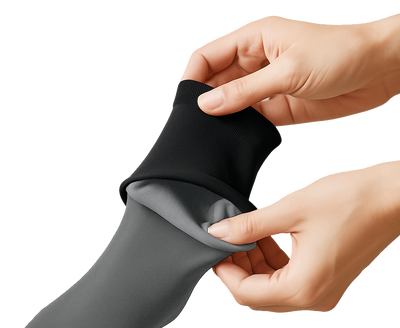Living with eczema

October is right around the corner and it brings us all the joys and colors of autumn. While it reminds us of crunchy leaves, hoodies and all-things pumpkin spice, the change of seasons can be brutal for people with eczema.
So, given that the Eczema Awareness month is waiting for us, and that we are leaving Eczema week (14–22 September 2019) behind us, we thought it would be a good idea to talk about this often-misunderstood disease. Firstly, we ought to seek out the answers about what eczema truly is in an attempt to break some myths and, as October suggests, raise awareness. So, to find the answers we gathered the questions you most often ask, all in one place.
Q1: What is eczema / how does eczema look like?
According to the National Eczema Organization, this name refers to a group of conditions which affect the skin, causing it to develop itchy, red or so to say – inflamed lesions. Eczema is often thought of as one disease when in reality there are six distinct types of it:
- Atopic dermatitis
- Contact dermatitis
- Seborrheic dermatitis
- Stasis dermatitis
- Dyshidrotic eczema
- Nummular eczema
The most common form is atopic dermatitis which is often the one people have in mind when talking about eczema. The word “atopic” indicates allergic reactions, meaning that people dealing with eczema, alongside redness and itchiness, are oftentimes dealing with allergies too. People who have atopic eczema are more like to develop other allergies, such as different food.
Eczema (in all its varieties) affects about 30 million Americans, as stated by the National Eczema Organization. In other words, it is a very common disease. In most cases, it is controllable, and it can be treated and cured, but as it goes from mild to severe, some cases are tougher to manage.
Even if it is often children and babies who develop eczema on their cheeks and face, it can also occur in adults and on other parts of bodies, such as hands. Eczema on hands is often seen among adults, even the once who did not suffer from it as children. In most children, the problem goes away as they grow, but it can come back.
However, as said before, there are ways of treating and holding the disease under control.
Q2: Is eczema contagious?
The answer is NO. Eczema is not contagious, so if you know someone with it you should relax or tell other people to relax in contact with you or another person who has it. It is not yet confirmed what is the real trigger that is causing eczema to appear, but it is most likely genetics in a combination with various allergens from the environment, such as soaps and detergents, pollen, food, etc.
Q3: Is eczema an autoimmune disease?
Atopic dermatitis, or abbreviated AD, is known to often go together with food allergies and other atopic conditions, but does it somehow belong to the specter of autoimmune diseases?
Some studies have shown that AD could imply the presence of autoimmune disorder. One of them found that people suffering from this condition have been affected by higher rates of different autoimmune disorders than those without it.
Another study confirms the connection between the two, which points out a possible need for screening patients dealing with eczema for autoimmune diseases. Many more studies follow these findings, meaning that there should be a reason to think of the AD as a possible result of the mentioned.
To conclude, we say YES – eczema has somewhat of relation with autoimmune problems.
Q4: What is the difference between eczema and psoriasis?
This one is very often questioned.
The two conditions resemble one another but detecting which is which, is an important step before applying therapy and treating the disease.
So, what IS the difference between the two?
Psoriasis is a chronic autoimmune disease which occurs when a person is affected by the overproduction of skin cells. Sadly, at present, we do not have a cure for it yet. There are, however, treatments that can put the condition in remission. As well as eczema, psoriasis is not contagious.
Now that we know the answer to the question “how does eczema look like?” we should learn how psoriasis looks like, so we could tell them apart.
Psoriasis is recognized by a thick layer of white scales. While eczema is always reddish and looks like an allergy which can carry blister-like occurrences, psoriasis has that distinct look of thickened ashy skin patches. It also most commonly affects elbows and knees.

This is the simplest way of making a distinction between these two conditions, but the best way to know it is to consider the opinion of a medical professional, as these characteristics may appear different on a different type of skin.
Q5: Eczema healing stages and treatment
Eczema has three stages:
- Acute stage
- Subacute stage
- Chronic stage
We call them the eczema healing stages because there are different focuses of treatment regarding the stage of condition a person develops, although every stage has proven to respond well with antihistamines and topical steroids.
The acute stage is considered a starting rash followed by blisters, redness, and pain, itching and swelling. The best treatments are antihistamines and hydrocortisone cream. Also, antibiotics can be prescribed for inflammation and pain.
The subacute stage is considered somewhat a transition between the first and third stage. That is the time when the rash progresses and the skin becomes scaly. Itching can be experienced as stinging. The symptoms appear as if they calmed down. The best medications for this stage are moisturizers for the skin to soften and coal tar for the burning.
The chronic stage lasts for about three to six months and is characterized by eczema flares, crack in the skin, skin breakdown, accentuated skin lines and darker skin patches. The symptoms are the most severe in this stage, so the best medications are those prescribed by a medical professional.
Q6: Is there a way of healing eczema naturally?
Before applying any kind of therapy, it is always better to first consult your doctor or dermatologist, especially if you don’t yet know what the cause to your symptoms is.
Natural treatment and home treatment are the best in the acute or subacute stage of the disease, because if it becomes severe; there is less chance that the symptoms will naturally go away. If your doctor gives you a prescription, it is the best to keep to it, but it is also very important to provide some additional home care to your prescribed medication, such as good moisturizers or creams.
The most effective way of naturally fighting the disease is bathing therapy. Your skin needs moisture and it needs to soften, so taking a nice and warm bath and applying moisturizer immediately after it will help your skin restore its gentleness. You must apply moisturizer or cream within 4 minutes after the bath because that is the time your pores are still open, and the skin accepts vitamins from the cream.

The best vitamins for eczema are vitamins B6 and vitamin D. Vitamin B6 can be found in all sorts of food - from pork, fish, and turkey, to beans and vegetables. People with AD have a very low level of vitamin D, and taking it affects so powerful on this condition that if nothing changes; it is probably not eczema at all. Vitamin D helps repair your skin, so having enough of it can prevent infections and inflammations.
Is shea butter good for eczema?
Of course! Shea butter is one of the most effective natural moisturizers. It is very powerful with all types of skin and it restores damaged skin cells. Shea butter is a great companion in the subacute stage as well as applying it after a bath. Believe us when we say you can never go wrong with shea butter because we use it as one of our 5 magical ingredients for healthy, smooth and soft skin. Along with those 4 ingredients, we use this moisturizer in all our products, because we know about quality skincare. Our gloves are not what you would exclusively call eczema gloves, but their moisturizing and replenish abilities can come in handy. Check them out!
Q7: How to get rid of eczema scars?
Eczema scars can be so unflattering. To get rid of them some people apply oatmeal to their bath therapy. Fill your tub with some oatmeal and warm water and soak in and relax for 20 minutes every day.
Also, a mixture of vitamin E and Aloe Vera can make a difference. In the end, a good moisturizer and frequent moisture is a key to restoring your skin cells, and for that we recommend – have a quick guess – that is right: Shea butter.
So now that you read this article, help us spread do word in the Eczema Awareness Month!





